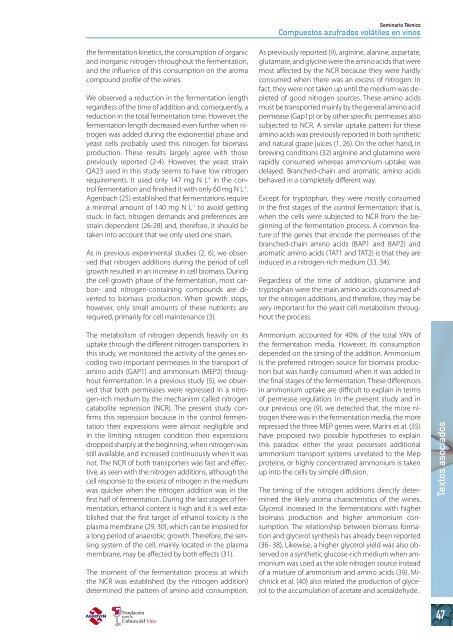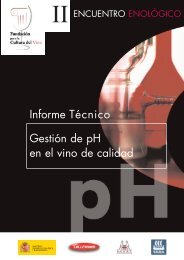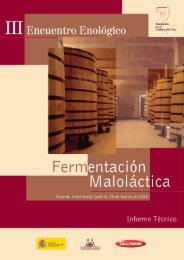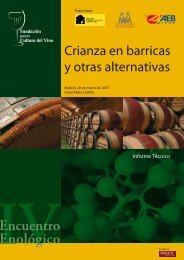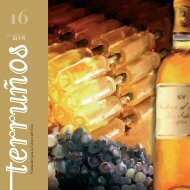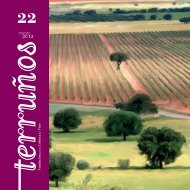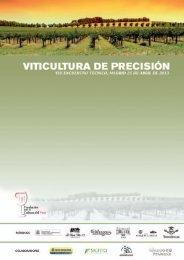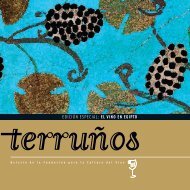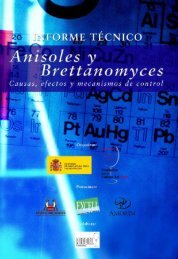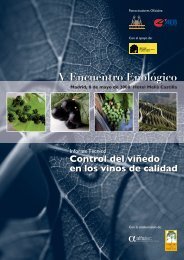Compuestos azufrados volátiles en vinos - Fundación para la ...
Compuestos azufrados volátiles en vinos - Fundación para la ...
Compuestos azufrados volátiles en vinos - Fundación para la ...
You also want an ePaper? Increase the reach of your titles
YUMPU automatically turns print PDFs into web optimized ePapers that Google loves.
Seminario Técnico<strong>Compuestos</strong> <strong>azufrados</strong> volátiles <strong>en</strong> <strong>vinos</strong>the ferm<strong>en</strong>tation kinetics, the consumption of organicand inorganic nitrog<strong>en</strong> throughout the ferm<strong>en</strong>tation,and the influ<strong>en</strong>ce of this consumption on the aromacompound profile of the wines.We observed a reduction in the ferm<strong>en</strong>tation l<strong>en</strong>gthregardless of the time of addition and, consequ<strong>en</strong>tly, areduction in the total ferm<strong>en</strong>tation time. However, theferm<strong>en</strong>tation l<strong>en</strong>gth decreased ev<strong>en</strong> further wh<strong>en</strong> nitrog<strong>en</strong>was added during the expon<strong>en</strong>tial phase andyeast cells probably used this nitrog<strong>en</strong> for biomassproduction. These results <strong>la</strong>rgely agree with thosepreviously reported (2-4). However, the yeast strainQA23 used in this study seems to have low nitrog<strong>en</strong>requirem<strong>en</strong>ts. It used only 147 mg N L -1 in the controlferm<strong>en</strong>tation and finished it with only 60 mg N L -1 .Ag<strong>en</strong>bach (25) established that ferm<strong>en</strong>tations requirea minimal amount of 140 mg N L -1 to avoid gettingstuck. In fact, nitrog<strong>en</strong> demands and prefer<strong>en</strong>ces arestrain dep<strong>en</strong>d<strong>en</strong>t (26-28) and, therefore, it should betak<strong>en</strong> into account that we only used one strain.As in previous experim<strong>en</strong>tal studies (2, 6), we observedthat nitrog<strong>en</strong> additions during the period of cellgrowth resulted in an increase in cell biomass. Duringthe cell growth phase of the ferm<strong>en</strong>tation, most carbon-and nitrog<strong>en</strong>-containing compounds are divertedto biomass production. Wh<strong>en</strong> growth stops,however, only small amounts of these nutri<strong>en</strong>ts arerequired, primarily for cell maint<strong>en</strong>ance (3).The metabolism of nitrog<strong>en</strong> dep<strong>en</strong>ds heavily on itsuptake through the differ<strong>en</strong>t nitrog<strong>en</strong> transporters. Inthis study, we monitored the activity of the g<strong>en</strong>es <strong>en</strong>codingtwo important permeases in the transport ofamino acids (GAP1) and ammonium (MEP2) throughoutferm<strong>en</strong>tation. In a previous study (5), we observedthat both permeases were repressed in a nitrog<strong>en</strong>-richmedium by the mechanism called nitrog<strong>en</strong>catabolite repression (NCR). The pres<strong>en</strong>t study confirmsthis repression because in the control ferm<strong>en</strong>tationtheir expressions were almost negligible andin the limiting nitrog<strong>en</strong> condition their expressionsdropped sharply at the beginning, wh<strong>en</strong> nitrog<strong>en</strong> wasstill avai<strong>la</strong>ble, and increased continuously wh<strong>en</strong> it wasnot. The NCR of both transporters was fast and effective,as se<strong>en</strong> with the nitrog<strong>en</strong> additions, although thecell response to the excess of nitrog<strong>en</strong> in the mediumwas quicker wh<strong>en</strong> the nitrog<strong>en</strong> addition was in thefirst half of ferm<strong>en</strong>tation. During the <strong>la</strong>st stages of ferm<strong>en</strong>tation,ethanol cont<strong>en</strong>t is high and it is well establishedthat the first target of ethanol toxicity is thep<strong>la</strong>sma membrane (29, 30), which can be impaired fora long period of anaerobic growth. Therefore, the s<strong>en</strong>singsystem of the cell, mainly located in the p<strong>la</strong>smamembrane, may be affected by both effects (31).The mom<strong>en</strong>t of the ferm<strong>en</strong>tation process at whichthe NCR was established (by the nitrog<strong>en</strong> addition)determined the pattern of amino acid consumption.As previously reported (9), arginine, a<strong>la</strong>nine, aspartate,glutamate, and glycine were the amino acids that weremost affected by the NCR because they were hardlyconsumed wh<strong>en</strong> there was an excess of nitrog<strong>en</strong>. Infact, they were not tak<strong>en</strong> up until the medium was depletedof good nitrog<strong>en</strong> sources. These amino acidsmust be transported mainly by the g<strong>en</strong>eral amino acidpermease (Gap1p) or by other specific permeases alsosubjected to NCR. A simi<strong>la</strong>r uptake pattern for theseamino acids was previously reported in both syntheticand natural grape juices (1, 26). On the other hand, inbrewing conditions (32) arginine and glutamine wererapidly consumed whereas ammonium uptake wasde<strong>la</strong>yed. Branched-chain and aromatic amino acidsbehaved in a completely differ<strong>en</strong>t way.Except for tryptophan, they were mostly consumedin the first stages of the control ferm<strong>en</strong>tation: that is,wh<strong>en</strong> the cells were subjected to NCR from the beginningof the ferm<strong>en</strong>tation process. A common featureof the g<strong>en</strong>es that <strong>en</strong>code the permeases of thebranched-chain amino acids (BAP1 and BAP2) andaromatic amino acids (TAT1 and TAT2) is that they areinduced in a nitrog<strong>en</strong>-rich medium (33, 34).Regardless of the time of addition, glutamine andtryptophan were the main amino acids consumed afterthe nitrog<strong>en</strong> additions, and therefore, they may bevery important for the yeast cell metabolism throughoutthe process.Ammonium accounted for 40% of the total YAN ofthe ferm<strong>en</strong>tation media. However, its consumptiondep<strong>en</strong>ded on the timing of the addition. Ammoniumis the preferred nitrog<strong>en</strong> source for biomass productionbut was hardly consumed wh<strong>en</strong> it was added inthe final stages of the ferm<strong>en</strong>tation. These differ<strong>en</strong>cesin ammonium uptake are difficult to exp<strong>la</strong>in in termsof permease regu<strong>la</strong>tion. In the pres<strong>en</strong>t study and inour previous one (9), we detected that, the more nitrog<strong>en</strong>there was in the ferm<strong>en</strong>tation media, the morerepressed the three MEP g<strong>en</strong>es were. Marini et al. (35)have proposed two possible hypotheses to exp<strong>la</strong>inthis <strong>para</strong>dox: either the yeast possesses additiona<strong>la</strong>mmonium transport systems unre<strong>la</strong>ted to the Mepproteins, or highly conc<strong>en</strong>trated ammonium is tak<strong>en</strong>up into the cells by simple diffusion.The timing of the nitrog<strong>en</strong> additions directly determinedthe likely aroma characteristics of the wines.Glycerol increased in the ferm<strong>en</strong>tations with higherbiomass production and higher ammonium consumption.The re<strong>la</strong>tionship betwe<strong>en</strong> biomass formationand glycerol synthesis has already be<strong>en</strong> reported(36- 38). Likewise, a higher glycerol yield was also observedon a synthetic glucose-rich medium wh<strong>en</strong> ammoniumwas used as the sole nitrog<strong>en</strong> source insteadof a mixture of ammonium and amino acids (39). Michnicket al. (40) also re<strong>la</strong>ted the production of glycerolto the accumu<strong>la</strong>tion of acetate and acetaldehyde.Textos asociados47


